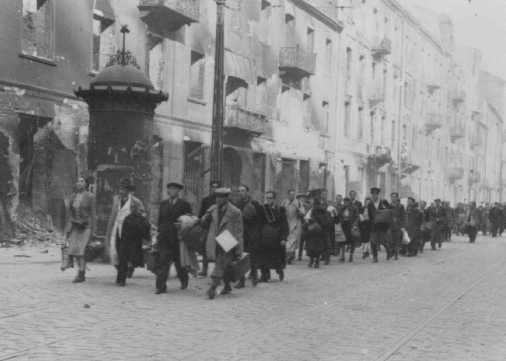World War II Letters about the Warsaw Ghetto Uprising
Posted by Gilder Lehrman Institute Staff on Thursday, 04/19/2018
 The Warsaw ghetto uprising began on April 19, 1943 when the Nazis tried to transport the remaining ghetto population to forced-labor centers and concentration camps. By May 16, 1943, the Germans had killed more than 7,000 Jews and deported almost 50,000 to the camps.
The Warsaw ghetto uprising began on April 19, 1943 when the Nazis tried to transport the remaining ghetto population to forced-labor centers and concentration camps. By May 16, 1943, the Germans had killed more than 7,000 Jews and deported almost 50,000 to the camps.
A year later, in May 1944, Sylvia Weiner, a social worker in New York City, saw the film None Shall Escape. Although it was produced during World War II, the film is set in a post-war era and tells the story of a Nazi officer on trial for war crimes. The cruelty of the Nazi regime is shown in flashbacks throughout the film. Sylvia decribed the film in a letter to her husband, Morris “Moe” Weiner, who was serving in the Army’s Quartermaster Corps:
We also saw “None Can Escape” & I can tell you that I came out with a heavy heart. It was a story which began as a trial of a Nazi, after the war had been won, and was a throw-back giving a picture of Poland before & after the Nazis came of course it showed the Poles tolerant of Jews (a Rabbi very friendly with the Catholic Priest) which may have been so in a particular case but truthfully the Poles were never too nice to the Jews. The Rabbi did a good job and the scene showing the massacre of the Jews was terrific. One reads of these things but seeing it is so different. Anyway, arrived home just now feeling rather low – the picture no doubt the cause.
—Sylvia Weiner to Morris “Moe” Weiner, May 22, 1944 (Punctuation standardized.)
In his response, Moe asked if the film included the Warsaw ghetto uprising and expressed his hope that “the world take note” of the Jews’ “display of faith” and “heroism.”
Does that picture [None Shall Escape] deal with the battle the Jews had in the Ghetto of Warsaw a little over a year ago? Reading the accounts which finally seeped through and were pieced together, was a compound of horror brutality and barbarism. But over and above all was heroism, heroism of the highest and most exalted order. These people decided not to take it lying down. They fought—and how they fought. Hopelessly, and that is the kind of fighting that takes sublime courage.
They asked only that the world take note of what was happening, and charged the world that their deaths be not in vain. It was nothing short of magnificent. As yet the world has taken little notice, and this display of faith and hope may have gone for naught. If true, what a pity – what a waste.
—Morris “Moe” Weiner to Sylvia Weiner, June 7, 1944
At the outbreak of World War II, Moe and Sylvia Weiner lived in Brooklyn, New York. Moe joined the Army’s Quartermaster Corps in 1943 while Sylvia worked for the Selective Service board. Over the course of three years, they wrote 1,530 letters to each other. Moe and Sylvia were both children of Eastern European Jewish immigrants.